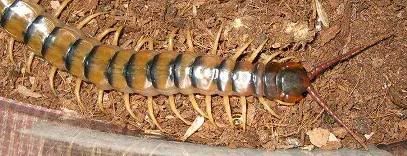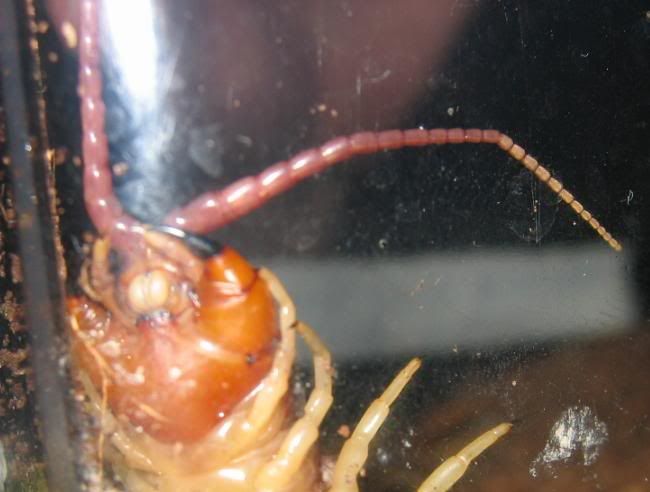- Joined
- Jan 5, 2005
- Messages
- 8,325
hello,
I put together a care/info sheet for Scolopendra polymorpha and would like comments on it. Please comment on anything, from accuracy to the fact you just plain don't like it... or me =P
Caresheet follow:
Scolopendra polymorpha
The author of the care sheet, Andrew Olson ~ cacoseraph, is no an expert and has not formal invertebrate education. Unless otherwise noted, the following is based on his personal observations and could very well be incorrect. Caveat Emptor.

Scolopendra polymorpha
This species should be kept as a drier giant centipede.
Type: Scolopendra, Giant Centipede
Flooring: terrestrial/burrowing
Conditions: Dry
Humidity: Dry
Temp. 70-85*F
Temperment: Nervous and Aggressive
Size: I have seen 6"BL and would not be suprised by 7"
Feeding: Crickets ,roaches,meal worms,etc
Substrate: peat moss,vemiculite,potting soil,Bed-A-Beast, Jungle Mix
Type/Natural History
This is a tough North American species. Found in U.S. states of CA, NV, AZ, TX for certain, and probably in some surrounding states. Likely found in Mexico. The range extends through most of Western United States, distribution map by R. Shelley here
This centipede is available under a host of common names. Geographic variation names often include state names, such as Texas Tiger Centipede. Reference to the coloration, specifically the banding are common. I purchased my largest polymorpha as "Arizona Blue-Banded Centipede". "Banded", "Striped", and "Tiger" are all possible parts of a common name for S. polymorpha. The strangest name i saw this sold under was "Striped Desert Centipede".
Substrate/Flooring
In the wild i find these centipedes under various size debris, such as boards, logs, stumps, mattresses, etc. Sometimes evidence of a scrape type of hide can be found, othertimes it appears the centipedes have made no modifications at all. I also find them in piles of garbage/decaying vegetation.
In captivity, so far all the specimens i have observed (25-30) have burrowed for at least some periods of time, if given the opportunity. This leads me to believe there are many more hidden centipedes in the wild, that i will never encounter.
If you are willing to possibly not see your centipede for months at a time, i would suggest you allow it a chance to burrow. If not, a hide is required. Otherwise the centipede is likely to become agitated when you open its container. Most centipedes are fairly secretive animals. Some are VERY secretive.
Conditions/Humidity/Temperature
I live inside this species native habitat. Therefore I have to pay less attention to these things. In an effort to let all my bug pets sync up with the seasons for breeding and molting purposes i keep my bedroom/bugroom window wide open with a fan drawing outside air in as much as possible. Hopefully, this will make cage conditions reflect outside conditions to a limited degree.
I used to only mist my giant centipedes, but a death of a favored captive made me change my mind. Now i religiously use 1oz tall condiment cups. These are tall enough that they retain water for a decent amount of time and also sometimes even stay free of dirt that most water dishes in centi enclosures seem to accumulate. It don't believe it is important to make sure the water dish is always full of water and clear of dirt... just make sure the centipede has access at least once a week.
One thing i have noticed, ventilation seems to be somewhat important to these guys. I found this suprising, as in the wild i would find them under a foot or two of decaying vegetation that was left in large mounds. Perhaps they stay more near the surface normally, and are driven deeper when they sense my presense. At any rate, S. polymorpha I kept in very humid and poorly ventilated containers seemed to die more often than my other guests.
Ventilation must be balance with access to moisture.
The following information is from Biology of Centipedes by Lewis (1981). Most centipedes have very poor moisture retention, leaking moisture out of their breathing spiracles. Scolopendramorphae have a limited ability to seal their spiracles against water loss, but are still more susceptible than a tarantula or scorpion.
Temperment
All giant centipedes should be considered nervous and defensive.
If you want to think about holding them, look at this:

Size
The eggs from my brother's ~3.5"BL (9cm) WC female appeared to be 3-6mm clear yellow "jelly" globes. These turned into postembryo/protonymps that were about 10-15mm long, with only 3 pairs of legs.
Measuring centipedes: From what i have read, the correct way to measure the length of a centipede is Body Length, or BL. Body Length consists for measuring the centipede from tip of face to tip of last body segment. Antenna and legs, terminal or otherwise, are NOT counted.
Females can be as small as 3"BL, and lay viable eggs.
I purchased an S. polymorpha from a petstore that is 6-6.5"BL (12-13cm), perhaps more when stretching out lengthwise.
Feeding
My centipedes eat mainly crickets. This is occasionally supplemented by mealworms, waxworms, roaches, and i know some of my centipedes bought from petstores were fed pinkies. A key to good pet nutrition is good feeder nutrition. I try to make sure my feeders have constant access to some form of food and water. I feed them a variety of fruits, vegetables, and commecial gut load.
I put together a care/info sheet for Scolopendra polymorpha and would like comments on it. Please comment on anything, from accuracy to the fact you just plain don't like it... or me =P
Caresheet follow:
Scolopendra polymorpha
The author of the care sheet, Andrew Olson ~ cacoseraph, is no an expert and has not formal invertebrate education. Unless otherwise noted, the following is based on his personal observations and could very well be incorrect. Caveat Emptor.

Scolopendra polymorpha
This species should be kept as a drier giant centipede.
Type: Scolopendra, Giant Centipede
Flooring: terrestrial/burrowing
Conditions: Dry
Humidity: Dry
Temp. 70-85*F
Temperment: Nervous and Aggressive
Size: I have seen 6"BL and would not be suprised by 7"
Feeding: Crickets ,roaches,meal worms,etc
Substrate: peat moss,vemiculite,potting soil,Bed-A-Beast, Jungle Mix
Type/Natural History
This is a tough North American species. Found in U.S. states of CA, NV, AZ, TX for certain, and probably in some surrounding states. Likely found in Mexico. The range extends through most of Western United States, distribution map by R. Shelley here
This centipede is available under a host of common names. Geographic variation names often include state names, such as Texas Tiger Centipede. Reference to the coloration, specifically the banding are common. I purchased my largest polymorpha as "Arizona Blue-Banded Centipede". "Banded", "Striped", and "Tiger" are all possible parts of a common name for S. polymorpha. The strangest name i saw this sold under was "Striped Desert Centipede".
Substrate/Flooring
In the wild i find these centipedes under various size debris, such as boards, logs, stumps, mattresses, etc. Sometimes evidence of a scrape type of hide can be found, othertimes it appears the centipedes have made no modifications at all. I also find them in piles of garbage/decaying vegetation.
In captivity, so far all the specimens i have observed (25-30) have burrowed for at least some periods of time, if given the opportunity. This leads me to believe there are many more hidden centipedes in the wild, that i will never encounter.
If you are willing to possibly not see your centipede for months at a time, i would suggest you allow it a chance to burrow. If not, a hide is required. Otherwise the centipede is likely to become agitated when you open its container. Most centipedes are fairly secretive animals. Some are VERY secretive.
Conditions/Humidity/Temperature
I live inside this species native habitat. Therefore I have to pay less attention to these things. In an effort to let all my bug pets sync up with the seasons for breeding and molting purposes i keep my bedroom/bugroom window wide open with a fan drawing outside air in as much as possible. Hopefully, this will make cage conditions reflect outside conditions to a limited degree.
I used to only mist my giant centipedes, but a death of a favored captive made me change my mind. Now i religiously use 1oz tall condiment cups. These are tall enough that they retain water for a decent amount of time and also sometimes even stay free of dirt that most water dishes in centi enclosures seem to accumulate. It don't believe it is important to make sure the water dish is always full of water and clear of dirt... just make sure the centipede has access at least once a week.
One thing i have noticed, ventilation seems to be somewhat important to these guys. I found this suprising, as in the wild i would find them under a foot or two of decaying vegetation that was left in large mounds. Perhaps they stay more near the surface normally, and are driven deeper when they sense my presense. At any rate, S. polymorpha I kept in very humid and poorly ventilated containers seemed to die more often than my other guests.
Ventilation must be balance with access to moisture.
The following information is from Biology of Centipedes by Lewis (1981). Most centipedes have very poor moisture retention, leaking moisture out of their breathing spiracles. Scolopendramorphae have a limited ability to seal their spiracles against water loss, but are still more susceptible than a tarantula or scorpion.
Temperment
All giant centipedes should be considered nervous and defensive.
If you want to think about holding them, look at this:

Size
The eggs from my brother's ~3.5"BL (9cm) WC female appeared to be 3-6mm clear yellow "jelly" globes. These turned into postembryo/protonymps that were about 10-15mm long, with only 3 pairs of legs.
Measuring centipedes: From what i have read, the correct way to measure the length of a centipede is Body Length, or BL. Body Length consists for measuring the centipede from tip of face to tip of last body segment. Antenna and legs, terminal or otherwise, are NOT counted.
Females can be as small as 3"BL, and lay viable eggs.
I purchased an S. polymorpha from a petstore that is 6-6.5"BL (12-13cm), perhaps more when stretching out lengthwise.
Feeding
My centipedes eat mainly crickets. This is occasionally supplemented by mealworms, waxworms, roaches, and i know some of my centipedes bought from petstores were fed pinkies. A key to good pet nutrition is good feeder nutrition. I try to make sure my feeders have constant access to some form of food and water. I feed them a variety of fruits, vegetables, and commecial gut load.
Last edited:
